2 - White to play and win
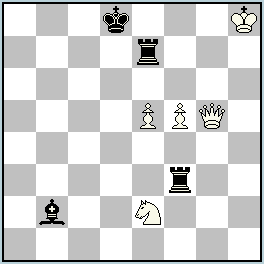
3k3K/4r3/8/4PPQ1/8/5r2/1b2N3/8
W : Kh8 Qg5 Né2 Pé5f5
B : Kd8 Ré7f3 Bb2
+ (5+4)
For nostalgics
3 - White to play and win
Henri RINCK
La Stratégie 1912-14
1st Prize
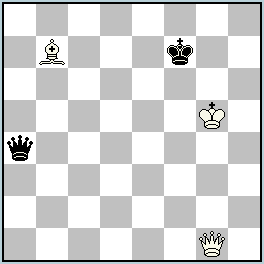
8/1B3k2/8/6K1/q7/8/8/6Q1
W : Kg5 Qg1 Bb7
B : Kf7 Qa4
+ (3+2) C-
Very nice in an airy position
For lovers of old style
4 - game of the day : Spielmann - Rubinstein 1925
1, e4 e5 2, Nf3 Nc6 3, Nc3 Nf6 4, Bb5 Nd4 5, Nxe5 Qe7 6, f4 Nxb5 7 Nxb5 d6 8, Nf3 Qxe4+ 9, Kf2
Ng4 10, Kg3 Qg6 !
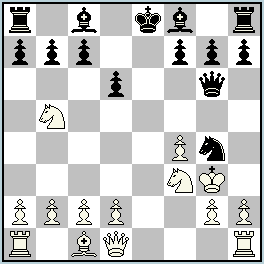
Nice move. Rubinstein had previously played Kd8 against Bogoljubov
The threat is, of course, Ne3+
11 Qe2+ Kd8 12 Re1 Bd7 13 Nbd4 Ne3+ 14 Kf2 Nxc2 15 Nxc2 Qxc2 16 b4 a5 !
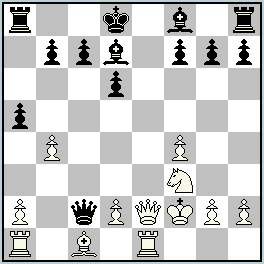
17 Ba3 ab
17 ... Qa4 18 Ng5
18 Bxb4 Qf5 ! 19 Qe3 h6 20 Rac1 Rg8 21 Kg1 g5 22 Qc3 Rc8 !
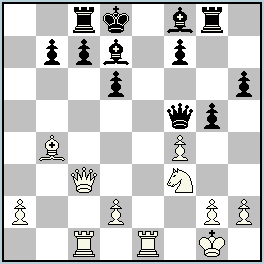
22 ... c5 is not very good 23 d4! and it starts to smell like a tree with Ba5+ to come
23 fg hg 24 Kh1 g4 25 Nd4 Qd5 !
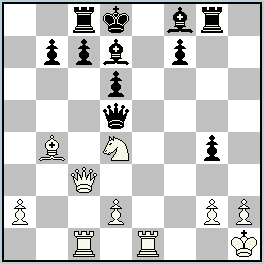
The threat was 26 Ba5 b6 27 Nc6+ Bxc6 28 Qxc6 Be7 29 Bxb6
26 Qe3 g3 ! 27 Bc3 Ra8 !!
switchblack !
28 Nf3 gh 29 Bf6+ Kc8 30 Qc3 Qc5 31 Qd3 Qh5 32 Ne5 ! Rxg2 !!
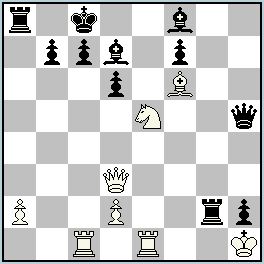
32 ... de 33 Rxe5 Q~ 34 Re8+!
33 Kxg2 de 34 Rxe5 Qg4+ 35 Qg3 QxQ+ 36 KxQ Bd6 37 Kxh2 Rxa2 38 Kg1 Rxd2 !
And Black ended up winning a few moves later
For those who like enchantment, a foray into the SuperGuards. A delight!
SuperGuards : a piece cannot be taken (including the King) if it is controlled by a piece of its camp
To begin an amusing discovery of the genre
5 - #2 Superguards
Juraj LORINC
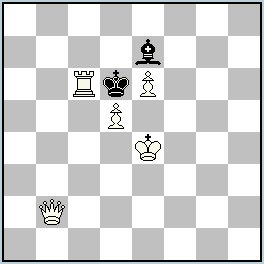
8/4b3/2RkP3/3P4/4K3/8/1Q6/8
W : Ké4 Qb2 Rç6 Pé6d5
B : Kd6 Bé7
‡2 (5+2)
To help you a bit, Kd6 is not in check because of Be7 and as a bonus, a typical variation
1. Ke5 Kc5 ? 2 Kd6!! is mate, but 1 ... Bf8! and there is no mate
A kind of task for the second SuperGuards :
6 - #2 SuperGuards
Gerard SMITS
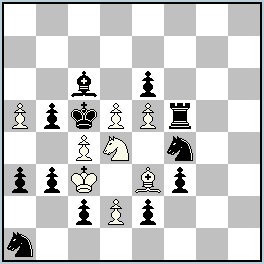
8/8/2b1p3/PpkPPr2/2PN1n2/ppK1Bp2/2pPp3/n7
W : Kç3 Bé3 Nd4 Pa5d5é5ç4d2
B : Kç5 Rf5 Bç6 Nf4a1 Pé6b5a3b3f3ç2é2
‡2 (8+12)
Very interesting with a nice richness on some moves
And the apotheosis with the last one
7 - h#3 SuperGuards
Borislav GADJANSKI

4n3/1N4R1/3r3k/4q2p/K7/4brp1/8/5N2
W : Ka4 Rg7 Nb7f1
B : Kh6 Qé5 Rd6f3 Bé3 Né8 Ph5g3
h‡3 (4+8)
A remarkable problem with superb mechanics.
a well-deserved first prize
The report is now complete.
I refer you to the electronic version of the Master for a more complete account of the game and of course some additional information.
Good reading to all and see you on November 26th.
Yours sincerely
le greffier
Add a comment